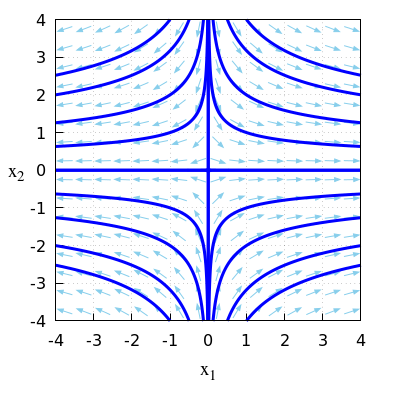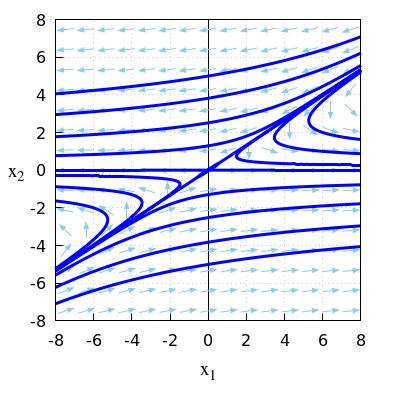Consider the vector quantity \(\vec{x}(t) = \cv{x_1(t)\\ x_2(t)}\) of which the change in time is given by the equation \(\frac{\dd\vec{x}}{\dd t} = A\,\vec{x}\) with matrix \[A =\matrix{3 & 0\\ 0 & -1}\]
-
Write the equation as a system of two linear differential equations.
-
What is the formula for the solution \(\vec{x}(t)\) at any time \(t\)?
-
What are successively \(\vec{x}(1), \vec{x}(2)\), \(\vec{x}(4)\) and \(\vec{x}(8)\) when \(\vec{x}(0)=\cv{1\\0}\)?
-
What are the answers to task (c) when \(\vec{x}(0)=\cv{0\\10}\)?
- What are the answers to task (c) when \(\vec{x}(0)=\cv{0.1\\10}\)?
-
The time profile of \(x_1(t)\) and \(x_2(t)\) is fixed for a given \(\vec{x}(0)\). The relationship between \(x_1\) and \(x_2\) can be graphically represented by a curve in the \(x_2\)-\(x_1\) plane (You may also say "in the \(y\)-\(x\) plane").
Give the general equation of the curves for an arbitrary choice of \(\vec{x}(0)=\cv{\alpha\\\beta}\).
\(\quad\frac{\dd}{\dd t}\vec{x}=A\, \vec{x}\quad\) with \(A =\matrix{3 & 0\\ 0 & -1}\)
- \(\quad\left\{\begin{aligned} \frac{\dd x_1}{\dd t} &= 3x_1\\[0.2cm] \frac{\dd x_2}{\dd t} &= -x_2\end{aligned}\right.\)
- \(\quad\left\{\begin{aligned} x_1(t) &= c_1\cdot e^{3t}\\[0.2cm] x_2(t) &= c_2\cdot e^{-t}\end{aligned}\right.\) with constants \(c_1\) and \(c_2\).
- \(\quad\vec{x}(0)=\cv{1\\0}\) means that \(x_1(0)=1\) en \(x_2(0)=0\).
\(\quad\)Substitution in the general solution (b) gives \(c_1=1\) and \(c_2=0\), and thus \(\vec{x}(t)=\cv{e^{3t}\\0}\).
\(\quad\)Then: \(\vec{x}(1)=\cv{e^{3}\\0},\quad \vec{x}(2)=\cv{e^{6}\\0}, \quad \vec{x}(4)=\cv{e^{12}\\0}, \quad \vec{x}(8)=\cv{e^{24}\\0}\).
- \(\quad\vec{x}(0)=\cv{0\\10}\) means that \(x_1(0)=0\) and \(x_2(0)=10\).
\(\quad\)Substitution in the general solution (b) gives \(c_1=0\) and \(c_2=10\),
\(\quad\)and thus \(\vec{x}(t)=\cv{0\\10e^{-t}}=\cv{0\\ \frac{10}{e^{t}}}\).
\(\quad\)Then: \(\vec{x}(1)=\cv{0\\ \frac{10}{e}},\quad \vec{x}(2)=\cv{0\\ \frac{10}{e^2}}, \quad \vec{x}(4)=\cv{0\\ \frac{10}{e^4}}, \quad \vec{x}(8)=\cv{0\\ \frac{10}{e^8}}\).
- \(\quad\vec{x}(0)=\cv{0.1\\10}\) means that \(x_1(0)=0.1\) and \(x_2(0)=10\).
\(\quad\)Substitution in the general solution (b) gives \(c_1=0.1\) and \(c_2=10\),
\(\quad\)and thus \(\vec{x}(t)=\cv{0.1e^{3t}\\10e^{-t}}=\cv{0.1e^{3t}\\ \frac{10}{e^{t}}}\).
\(\quad\)Then: \(\vec{x}(1)=\cv{0.1e^3\\ \frac{10}{e}},\quad \vec{x}(2)=\cv{0.1e^6\\ \frac{10}{e^2}}, \quad \vec{x}(4)=\cv{0.1e^{12}\\ \frac{10}{e^4}}, \quad \vec{x}(8)=\cv{0.1e^{24}\\ \frac{10}{e^8}}\).
- \(\quad\vec{x}(0)=\cv{\alpha\\ \beta}\) means that \(x_1(0)=\alpha\) en \(x_2(0)=\beta\).
\(\quad\)Substitution in the general solution (b) gives: \(c_1=\alpha\) en \(c_2=\beta\).
\(\quad\)Thus: \(\vec{x}(t)=\cv{\alpha\cdot e^{3t}\\ \beta\cdot e^{-t}}=\cv{\alpha\cdot e^{3t}\\ \dfrac{\beta}{e^{t}}}\).
\(\quad\)The above formula is the parameter representation of the general solution.
\(\quad\)This solution satisfies the following equation: \(x_1\cdot x_2^3=\alpha\beta^3\).
\(\quad\)Thus, any solution satisfies \(x_1\cdot x_2^3=c\) for some constant \(c\).
\(\quad\)This is illustrated in the phase portrait below.
\(\quad\)
Consider the vector quantity \(\vec{x}(t) = \cv{x_1(t)\\ x_2(t)}\) of which the change in time is given by the equation \(\frac{\dd\vec{x}}{\dd t} = A\,\vec{x}\) with matrix \[A =\matrix{3 & -6\\ 0 & -1}\]
-
Calculate the eigenvalues and vectors of \(A\).
-
What is the formula for the solution \(\vec{x}(t)\) at any time \(t\)?
-
What are successively \(\vec{x}(1), \vec{x}(2)\), \(\vec{x}(4)\) and \(\vec{x}(8)\) when \(\vec{x}(0)=\cv{1\\0}\)?
-
What are the answers to task (c) when \(\vec{x}(0)=\cv{1\\ \frac{2}{3}}\)?
- What are the answers to task (c) when \(\vec{x}(0)=\cv{1\\ 0.666}\)?
- What are the answers to task (c) when \(\vec{x}(0)=\cv{1\\ 0.668}\)?
-
Give a qualitative description of the general solution:
- How do the solution curves look like? Give a sketch.
- What is the nature of the equilibrium \((0,0)\).
\(\quad\frac{\dd}{\dd t}\vec{x}=A\, \vec{x}\quad\) with \(A = \matrix{3 & -6\\0 & -1\\}\)
- \(\quad\)The characteristic polynomial of \(A\) is because of its upper triangular shape
\(\quad\)equal to \((\lambda-3)(\lambda+1)\)
\(\quad\)The eigenvalues of \(A\) are zeros of the characteristic polynomial: \(3\) and \(-1\).
\(\quad\)Let \(\cv{v_1\\ v_2}\) be an eigenvector corresponding to the eigenvalue \(3\):
\(\quad\)\(\matrix{3 & -6\\0 & -1\\}\cdot \cv{v_1\\ v_2}=3\cv{v_1\\ v_2}\).
\(\quad\)Then: \(\left\{\begin{aligned} 3v_1-6v_2 &= 3v_1 \\[0.2cm] -v_2 &= 3v_2\end{aligned}\right.\)
\(\quad\)Thus: \(v_2=0\) and an eigenvector corresponding to the eigenvalue \(3\) is \(\cv{1\\0}\).
\(\quad\)Let \(\cv{v_1\\ v_2}\) be an eigenvector corresponding to the eigenvalue \(-1\):
\(\quad\)\(\matrix{3 & -6\\0 & -1\\}\cdot \cv{v_1\\ v_2}=-\cv{v_1\\ v_2}\).
\(\quad\)Then: \(\left\{\begin{aligned} 3v_1-6v_2 &= -v_1 \\[0.2cm] -v_2 &= -v_2\end{aligned}\right.\)
\(\quad\)So: \(v_2\) can be freely chosen and then \(4v_1-6v_2=0\), i.e. \(v_2=\tfrac{2}{3}v_2\).
\(\quad\)An eigenvector corresponding to the eigenvalue \(-1\) (with integral coefficients) is \(\cv{3\\2}\).
- \(\quad\)The general solution is \[\begin{aligned}\vec{x}(t)&=\alpha\cdot e^{3t}\cdot\cv{1\\0}+ \beta\cdot e^{-t}\cdot\cv{3\\2}\\ \\ &= \cv{\alpha\cdot e^{3t}+3\beta\cdot e^{-t}\\ 2\beta\cdot e^{-t}}\end{aligned}\] \(\quad\) for certain constants \(\alpha\) and \(\beta\).
- \(\quad\vec{x}(0)=\cv{1\\0}\) means \(x_1(0)=1\) and \(x_2(0)=0\).
\(\quad\)Substitution in the general solution (b) gives \(\alpha=1\) and \(\beta=0\),
\(\quad\)and thus \(\vec{x}(t)=\cv{e^{3t}\\0}\).
\(\quad\)Then: \(\vec{x}(1)=\cv{e^{3}\\0},\quad \vec{x}(2)=\cv{e^{6}\\0}, \quad \vec{x}(4)=\cv{e^{12}\\0}, \quad \vec{x}(8)=\cv{e^{24}\\0}\).
- \(\quad\)When \(\vec{x}(0)=\cv{1\\ \frac{2}{3}}\) then \(\vec{x}(0)=\frac{1}{3}\cv{3\\ 2}\).
\(\quad\)Substitution in the general solution (b) gives \(\alpha=0\) and \(\beta=\frac{1}{3}\),
\(\quad\)and thus \(\vec{x}(t)=\frac{1}{3}e^{-t}\cdot\cv{3\\2}= \cv{\frac{1}{e^t}\\ \frac{2}{3e^t}}\).
\(\quad\)Then: \(\vec{x}(1)=\cv{\frac{1}{e}\\ \frac{2}{3e}},\quad \vec{x}(2)=\cv{\frac{1}{e^2}\\ \frac{2}{3e^2}}, \quad \vec{x}(4)=\cv{\frac{1}{e^4}\\ \frac{2}{3e^4}}, \quad \vec{x}(8)=\cv{\frac{1}{e^8}\\ \frac{2}{3e^8}}\).
- \(\quad\vec{x}(0)=\cv{1\\0.666}\) is close to \(\cv{1\\ \frac{2}{3}}\).
\(\quad\)Because \(0.666\) not exactly equal to \(\frac{2}{3}\) the solution curve deviates,
\(\quad\)but stays in the beginning (and in the past) nearby.
\(\quad\)The deviation from \(\cv{1\\0.666}\) with \(\cv{1\\ \frac{2}{3}}\) : \[\begin{aligned}\cv{1\\0.666}&=\cv{\frac{2}{3}\cdot \frac{1}{0.666}\\ \frac{2}{3}}= \cv{\frac{2}{1.998}\\ \frac{2}{3}}\\ &=\cv{\frac{2}{1.998}-1\\ 0}+\cv{1\\ \frac{2}{3}}\\ &=\cv{\frac{0.002}{1.998}\\ 0}+\cv{1\\ \frac{2}{3}}\\ &=\frac{2}{1998}\cdot\cv{1\\0}+ \cv{1\\ \frac{2}{3}}\\ &=\frac{1}{999}\cdot\cv{1\\0}+\frac{1}{3}\cdot\cv{3\\ 2}\end{aligned}\] \(\quad\) In the general solution (b) we have \(\alpha=\frac{1}{999}\) and \(\beta=\frac{1}{3}\) i.e. \[\vec{x}(t)= \frac{1}{999}e^{3t}\cdot\cv{1\\0}+\frac{1}{3}\beta e^{-t}\cdot\cv{3\\2}\] \(\quad\)Then: \[\begin{aligned}\vec{x}(1) &= \frac{1}{999}e^{3}\cdot\cv{1\\0}+\frac{1}{3e}\cdot\cv{3\\2} \\ \\ \vec{x}(2) &= \frac{1}{999}e^{6}\cdot\cv{1\\0}+\frac{1}{3e^2}\cdot\cv{3\\2}\\ \\ \vec{x}(4) &= \frac{1}{999}e^{12}\cdot\cv{1\\0}+\frac{1}{3e^4}\cdot\cv{3\\2}\\ \\ \vec{x}(8) &= \frac{1}{999}e^{24}\cdot\cv{1\\0}+\frac{1}{3e^8}\cdot\cv{3\\2}\approx \cv{2.65\cdot 10^7\\ 0.006}\end{aligned}\]
- \(\quad\vec{x}(0)=\cv{1\\0.668}\) is close to \(\cv{1\\ \frac{2}{3}}\).
\(\quad\)Because \(0.668\) the solution curve deviates,
\(\quad\)but stays in the beginning (and in the past) nearby.
\(\quad\)The deviation from \(\cv{1\\0.668}\) with \(\cv{1\\ \frac{2}{3}}\): \[\begin{aligned}\cv{1\\0.668}&=\cv{\frac{2}{3}\cdot \frac{1}{0.668}\\ \frac{2}{3}}= \cv{\frac{2}{2.004}\\ \frac{2}{3}}=\cv{\frac{1}{1.002}\\ \frac{2}{3}}\\ &=\cv{\frac{1}{1.002}-1\\ 0}+\cv{1\\ \frac{2}{3}}\\ &=\cv{\frac{-0.002}{1.002}\\ 0}+\cv{1\\ \frac{2}{3}}\\ &=-\frac{1}{501}\cdot\cv{1\\0}+\frac{1}{3}\cdot\cv{3\\ 2}\end{aligned}\] \(\quad\)In the general solution (b) we have \(\alpha=-\frac{1}{501}\) and \(\beta=\frac{1}{3}\) i.e. \[\vec{x}(t)= -\frac{1}{501}e^{3t}\cdot\cv{1\\0}+\frac{1}{3}\beta e^{-t}\cdot\cv{3\\2}\] \(\quad\)Then: \[\begin{aligned}\vec{x}(1) &= -\frac{1}{501}e^{3}\cdot\cv{1\\0}+\frac{1}{3e}\cdot\cv{3\\2} \\ \\ \vec{x}(2) &=- \frac{1}{501}e^{6}\cdot\cv{1\\0}+\frac{1}{3e^2}\cdot\cv{3\\2}\\ \\ \vec{x}(4) &= -\frac{1}{501}e^{12}\cdot\cv{1\\0}+\frac{1}{3e^4}\cdot\cv{3\\2}\\ \\ \vec{x}(8) &= -\frac{1}{501}e^{24}\cdot\cv{1\\0}+\frac{1}{3e^8}\cdot\cv{3\\2}\approx \cv{-5.29\cdot 10^7\\ 0.006}\end{aligned}\]
- \(\quad(0,0)\) is an equilibrium.
\(\quad\)A solution to the line \(x_2 = \frac{2}{3} x_1 \) moves toward the equilibrium
\(\quad\)A solution curve that starts close to the line \(x_2=0\) moves away from the equilibrium.
\(\quad\)A solution curve that starts close to the line \(x_2=\frac{2}{3}x_1\) moves away from it and
\(\quad\)goes to a horizontal axis.
\(\quad\)The equilibrium \((0,0)\) is a saddle point.
\(\quad\)This is also illustrated in the phase portrait below.
\(\quad\) 
\(\quad\)Each solution satisfies the equation \((2x_1-3x_2)\cdot x_2^3=c\) for some constant \(c\).
 Pencil-and-paper exercise set 1
Pencil-and-paper exercise set 1




